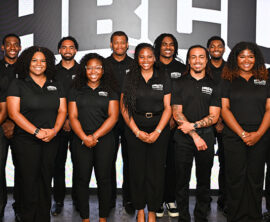Key takeaways
- Business is shifting globally. The global wholesale and retail cross-border payments market is forecasted to hit $320 trillion by 2032, according to a 2025 FXC Intelligence report.
- AI tools, human targets. Hackers behind successful cyber incidents are using artificial intelligence to exploit human errors through social engineering attacks, according to Wells Fargo experts. Financial services firms are a common target.
- How to defend? Humans armed with AI. Correspondent banks and the businesses that rely on them can thwart hackers and reduce operational risks by equipping their teams with AI, Wells Fargo experts say.
- Today’s innovation opportunity: For correspondent banks, the new ISO 20022 standard is a chance to take advantage of richer, more structured data to improve AI training models.
Businesses worldwide are embracing embedded finance and cross-border payments, making banking simultaneously more central and more exposed.
While open banking is unlocking plenty of benefits, it may be attracting new threats, too. But the real vulnerability of businesses and their financial institutions may not be the one they think it is.
Today’s headlines show what these threats look like: Deepfake financial leaders, mass social engineering scams, and voice impersonation tricks. Hackers are using artificial intelligence to target employees in the financial services industry by hacking human behavior.
How can businesses and their banks defend themselves? By taking a page out of the hackers’ playbook.
Hackers’ primary target: Your people
AI is lowering the barrier to entry of cybercrime, said Sarah Gosler, head of Cyber Human Defense at Wells Fargo. The latest AI tools have allowed hackers to more easily develop sophisticated attacks, from scaling spear-phishing emails or writing malicious code to creating personalized deep fakes.
The same tools trained on human-created data are being used to exploit companies in human ways. Social engineering tactics are behind most cyberattacks, according to a 2025 Palo Alto Networks report. Most successful breaches involve a human element (PDF), such as errors, social engineering, or using stolen credentials, according to the 2025 Verizon Data Breach Investigations Report.
How Wells Fargo is helping clients maximize ISO 20022’s benefits
Hear from Angelica Alam, Wells Fargo’s head of financial institutions and non-bank financial institutions product solutions, on how the new standard is creating opportunities for industry collaboration on the Treasury Takeaways podcast.
In fact, an AI bot based on a popular large language model (LLM) was used in a string of successful cyberattacks to find and prioritize vulnerabilities, write malicious code, and even draft personalized ransom notes.
The impact of this is that cyber criminals / cyberattacks have become a problem across enterprises, as hackers increasingly target organizations’ employees instead of or in addition to digital defenses, Gosler said.
“Humans now represent the largest attack surface,” she said. “[That’s why] we’re helping to bring clients on the journey with us, so they are developing good cyber hygiene just as we are.”
Why cross-border payments need an AI defense
AI tools allow hackers to scale attacks, but they can also allow businesses and banks to scale their defenses.
For example, companies can use AI to proactively monitor trillions of data points to find patterns and flag breaks that might signal a potential threat. Employees can then review flagged data points and escalate if necessary.
AI has an array of potential uses, from anti-money laundering (AML) tools to fraud analytics and detection programs, to bolster the cybersecurity of their employees. These tools could reduce operational risks by identifying human errors, flagging mistakes before they happen or before they can be exploited by bad actors.
The best strategy for thwarting AI-driven cyberattacks is holistic, using AI and human defenses in tandem, Gosler said.
“Just as hackers deconstruct technology, they expertly deconstruct the way humans think,” Gosler said. “Adversaries are using AI as a weapon. Companies can use it as a defense. The real battle is won when we empower humans and leverage AI, together, against these evolving threats.”
Why ISO 20022 implementation is the opportunity to embrace AI
“When your data is richer, more accessible, and easier to trace, it enhances the precision of fraud prevention and AML screening.”
It’s an opportune moment for businesses and banks to invest in their AI defenses as the payments industry shifts to adopt ISO 20022 by the end of 2025.
The new global standard for most financial messaging may mean that correspondent banks and their partners will have access to more detailed and structured payment data.
This data can help companies make the models behind their AI tools even better, said Angelica Alam, Wells Fargo’s head of financial institutions and non-bank financial institutions product solutions. “When your data is richer, more accessible, and easier to trace, it enhances the precision of fraud prevention and AML screening. In sanctions screening, for example, better data means fewer false positives and sharper focus on real risk,” she said.
Beyond cybersecurity, the new standard has the potential to improve other AI tools in the correspondent banking space, Alam said. For example, Wells Fargo has already deployed AI-driven fraud prevention and detection tools and is in the process of deploying agentic solutions for payment repairs and improving the operator side of payments. In other areas of the organization, generative AI can act like a prediction engine to potential fraud.
What the correspondent banking partner of the future looks like
As more businesses and banks seek opportunities in global payments, it behooves them to rise to the challenge of today’s cyberthreats, AI included. Having a partner that’s investing in AI cybersecurity is critical, Gosler said.
“We see AI not just as a threat, but as a powerful ally in our mission to defend the company and our clients,” she said. “Our strategy is to use AI to augment our human capabilities, making our defenses smarter, faster, and more adaptive.”
Trust is the foundation of banking. It’s why today’s correspondent banks must maintain the security of their transactions while working across borders and transaction partners. The consequences of a successful breach or scam can be severe, from lost funds to tarnished reputations, Alam said.
“Whether we’re moving the dollar onshore or offshore, our clients trust us to do so in a safe and reliable way,” she said.






